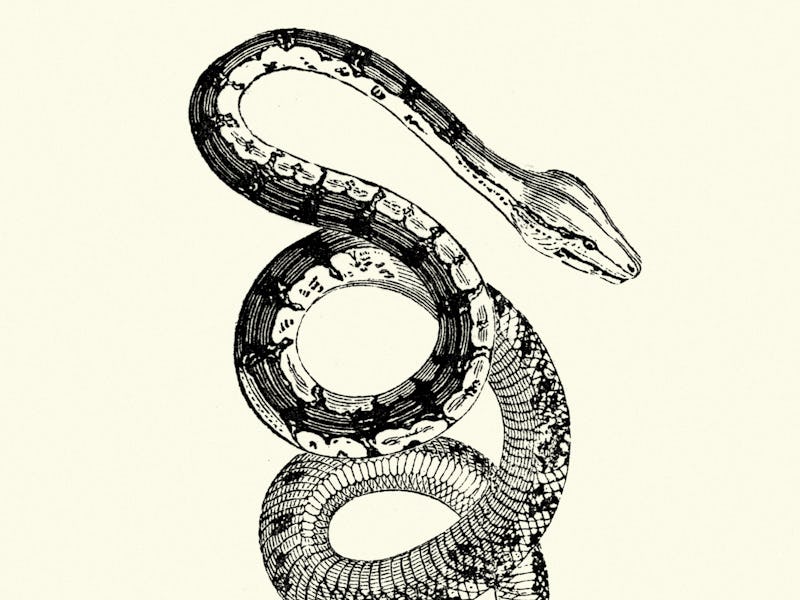Controversial theory explains the link between Wuhan coronavirus and snakes
A new study sheds light on the possible origins of the mystery virus.

Wuhan, China, a port city of more than 11 million people, is under lock-down as authorities attempt to limit the spread of a mysterious virus. At the time of writing, more than 600 people have been sickened with it across the globe, and several people have died. Dubbed 2019-nCoV, the virus is thought to be a coronavirus — the same kind of virus as SARS. As authorities deliberate over whether the virus is an international public health emergency, scientists think they now know something that will be critical in the fight against the virus' spread — where it came from in the first place.
The original source of the coronavirus is snakes, according to a study published this week in the Journal of Medical Virology. More specifically, the Chinese cobra and the Chinese krait, both of which are common in southern China and highly venomous.
To understand how the virus could have made the leap from snakes to humans, Inverse spoke to Adolfo Garcia Sastre, professor at the Icahn School of Medicine at Mount Sinai in New York and infectious disease expert (he was not part of the new study). He tells Inverse that the transmission of viruses from snakes to humans “is very unusual.”
Instead, the transmission of bacteria from reptiles to humans, such as Salmonella, is more common, he says.
To reach their snake-based hypothesis, a team of Chinese researchers took samples of the virus and determined its genetic code, before comparing it to the genetic sequences of other known coronaviruses. Their analysis reveals that 2019-nCoV is closely related to two separate coronavirus samples found in Chinese bats.
Medical personnel interact with two patients tested positive to coronavirus in Ho Chi Minh City.
Previous field studies show bats are the original source of two other severe coronaviruses, SARS-CoV and MERS-CoV. But other animals served as the intermediate hosts between bats and humans infected with either virus: Camels and masked palm civets, a mongoose-like mammal.
Further analyses of the new virus’ RNA coding sequence reveals that 2019-nCoV is also likely a mutated form of a virus in bats. That suggests this may be another case where an intermediate host animal is involved. To find out if that was the case, the researchers analyzed protein codes favored by 2019-nCoV and compared it to the protein codes from other coronaviruses found in different animal hosts.
The protein codes in this virus are most similar to those in snakes, suggesting that the virus resides in snakes before it is transmitted to people. It's possible that the first people infected in Wuhan encountered the snakes while at a local seafood market, the scientists say.
How do animals transmit viruses to people?
The study authors hypothesize that 2019-nCoV consists of a “recombination” of a viral protein that recognizes and binds to receptors on host cells. That allows the virus to enter host cells, which leads to infection and disease.
In turn, the study indicates that the virus is a zoonotic disease — a disease caused by infections that can spread between animals in people. There are many zoonotic diseases, and they can be caused by viruses, bacteria, parasites, or fungi. These kinds of diseases are pernicious — the United States' Centers for Disease Control and Prevention estimates that 75 percent of emerging infectious diseases that affect humans have an animal origin, while 60 percent of all human pathogens are zoonotic. That includes diseases we consider distinctly human, like measles and smallpox.
In theory, it’s possible to catch a viral infection from all sorts of animals, Garcia-Sastre says. But outbreaks of zoonotic infections are sporadic. They often start in a limited geographical area and are far less frequent than other common viral infections that spread between humans, he says.
A Chinese cobra.
But some viruses are more likely to cause zoonotic infections — take influenza, Ebola virus, or Nipah viruses for example. This depends on the host tropism of the virus, Garcia-Sastre says.
“Some can infect multiple species, some others can not,” he says. “In general, RNA viruses are more likely to jump host species.”
Viruses may jump from host species to host species when they mutate. Dogs, for example, can catch influenza that originates in birds, spread it to pigs, and then catch it again from the pigs. Humans, meanwhile, can also catch avian flu, although public health officials fear that avian influenza A viruses could mutate and gain the ability to spread faster.
After snakes, the second most likely animal reservoir for the new virus are marmots, although the chances of marmots being to blame are far less likely, the study authors argue. Still, the South China Morning Post reports the finding has sparked controversy within China’s research community.
The criticism there is that, while it’s an interesting hypothesis, more animal experiments are needed to determine if snakes really are the culprits. Other scientists say there's simply not enough evidence to say whether it is true snakes initially spread the virus.
As the situation develops, bigger mysteries remain unsolved: If the snake hypothesis turns out to be correct, scientists don’t know how a virus could adapt to both cold-blooded and warm-blooded hosts — or where it might travel to next.